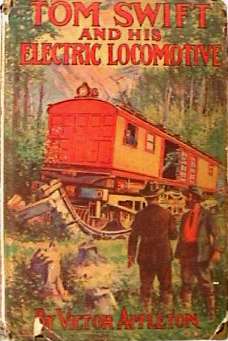 Note:
some of the language, references & attitudes, while acceptable at the time they
were written, are not Politically Correct, today.
Note:
some of the language, references & attitudes, while acceptable at the time they
were written, are not Politically Correct, today.Tom Swift and His Electric Locomotive
or, Two Miles a Minute on the Rails
By Victor Appleton ©1922 Book #25
Review by JP Karenko, September 2005
Duotone image courtesy of Mark Snyder
 Note:
some of the language, references & attitudes, while acceptable at the time they
were written, are not Politically Correct, today.
Note:
some of the language, references & attitudes, while acceptable at the time they
were written, are not Politically Correct, today.
Summary:
No official summary was ever provided with any of the old Tom Swift books. However, without giving too much away, the plot can be summed up as follows:
Nothing gets the old Swift Inventive Juices flowing like a good challenge. Tom is enjoined to design and build an electric railroad locomotive from scratch that will top 120mph and drag a string of loaded freight cars up a 2% mountain grade without slowing to a crawl. Richard Bartholomew is a hard-drivin' rail tycoon, beset by rivals that are trying to put his Western road under by devious and illegal means.
When Tom takes the contract, he joins Mr. B on the bullseye, waiting for the next threat to emerge. High explosives, armed robbery, sabotage, and subterfuge ensue. Then, there are the hazards of trying to control a half a million pounds of runaway loco on a mountain grade. You'll have to read the story to find out the details.
This book is available on line at: Tom Swift and His Electric Locomotive
![]()
Cast of Characters (More or less in order of appearance)
 Barton
Swift-Widower. Wealthy and
conservative. Inventor master machinist and holder of numerous patents. In this
episode, he is described as "semi invalid," Mr. Swift, has failed in his health
of late, but "still enjoys fine cigars."
Barton
Swift-Widower. Wealthy and
conservative. Inventor master machinist and holder of numerous patents. In this
episode, he is described as "semi invalid," Mr. Swift, has failed in his health
of late, but "still enjoys fine cigars."
Richard Bartholomew-Short, with olive complexion. President Hendrickton & Pas Alos RR. Tycoon & speculator.
Tom Swift-Intrepid inventor & mechanic. Plucky, lively, resourceful, brave and clever. Home-schooled at a college level by his father, Barton Swift. Athlete and hunter. Familiar with how to stalk game and firearms. Loves all things mechanical. Is a decent cook, too.
Eradicate Andrew Jackson Abraham Lincoln Sampson, A.K.A. Rad-Aged stereotypical Negro journeyman jack-of-all-trades. "Eradicates dirt." Eradicate has now "become too old to do much," but remains faithful to Tom and helps out where he can. Constant rival and antagonist of giant Koku.
Nocturnal Highwayman-Burly footpad who attacks Tom with a club & robs him. Later determined to be Andy O'Malley.
Miss Mary Nestor-Betrothed love interest who lives on the east side of Shopton. Described as a "very pretty young woman with flashing brown eyes, and a sweet trilling laugh." Blushes easily, especially around Tom.
Mr. Wakefield Damon-Elderly & eccentric adventurer whose main purpose in life seems to be blessing everybody and everything near his person. Apparently quite wealthy. In this episode, he has chicken troubles.
Ned Newton-Chum & companion of Tom. No description given. He has resumed his position as Swifts' financial advisor and CFO of Swift Construction Company.
Koku-Giant manservant of Tom. Devoted, loyal, and possessed of great strength, but apparently somewhat limited cognitive facilities. Described as "savage and only half-tame," he is antagonist and rival of Eradicate. In this episode, he chases Rad with a 10-foot spear, and must be cautioned not "to kill Tom's enemies" without express permission from his master.
Mr Stanley-NFN or description. Shopton bank VP.
The Bombers
Joe Myrick-Small, neat dresser. Wears a VanDyke beard.
Andy O'Malley-Burly westerner, rough dresser, wears size 12 boots. Is said to be cruel, desperate and a "notorious gunman," leading one to believe he typically goes armed.
McAvoy-NFN or description. Swift Construction foreman.
Mr. Toasty-Later determined to be Joe Myrick. Gets hung up in Swift Construction's electric fence.
Nugent-NFN or description. Swift Construction watchman. Ex-Blatz employee.
Mr. Blatz-NFN or description, except "hungry eyes." Owner, Blatz Detective Agency.
Express Train Conductor-No name or description.
George the Porter- No name or description, except Negro.
Montague Lewis-Solid build, grey hair, black moustache. Smokes long black cigars. President Hendrickton & Western RR.
Halfway Telegraph Operator- No name or description. Warns H&PA yards of Tom's runaway loco.
![]()
Major Inventions:
The Hercules 0001 is a 285ton, electric drive locomotive, in the 4-12-4 configuration. (See Engineering Fact vs. Fiction) The 12 main driving wheels are 70in. diameter, and powered by 6 dual-motor DC power plants, totaling 4400hp. Power is supplied by a twin pantograph overhead pickups, fed by 3000VDC. The locomotive is 90ft OAL, 10ft wide, and 14ft tall. The planned top speed is 120mph on level track, and the loco is intended to maintain a lesser, but still impressive speed on a 2% grade, which is quite steep, but not unusual for mountain routes.
These specifications are a typical 50-100% improvement over then-current technology, as represented by the Baldwin-Westinghouse and Jandel (See Errata) locomotives of the day.
A minor device that gets some notice is a small self-defense squirt-gun loaded with liquid Ammonia solution. Tom sprays this into an attacker's eyes to foil a robbery attempt. "Bless my pepper spray!" as Mr. Damon would say. He has one, too.
![]()
Commentary on Society, Attitudes, Environment & Errata
It's amazing how much technology and society have changed. Reading the old Tom Swift Sr. series has really given me an appreciation of some of the modern gadgets that I've come to take for granted. Some of the real-world electric locomotives similar to Tom's design were actually in service until as little as 30 years ago. Society's attitudes (or at least the authors') have changed, greatly, too. I wonder what people will be taking for granted 100 years from now, and what they will think of our "modern" society and its' mores (or lack of them...)
Attitudes and Prejudices-Language usage was "quaint," with several "Swifties" showing up in the text. This author is an old hand, and I'm identifying him as "Ejaculatin' Jones," since he repeatedly uses the term (8 times) in the text. This is the same writer who did Land of Wonders and Undersea Search, the other stories where the term is used repeatedly.
Koku and Rad's goodwill efforts from the previous volume have come to naught in this tale, as Koku chases Rad through the Swift household with a 10ft long spear. Rad would have a good case for charging Koku with felonious assault and attempted murder since he ends up taking a dive through Tom's 2nd floor bathroom window and ends up on the roof of the porch to escape the "half-tame" giant. Koku makes repeated threats to kill Tom's enemies, and much ado is made of Tom forbidding him to kill anyone without express permission. "Tottering" Rad seems no worse for wear, in spite of repeated comments about his frail and elderly condition.
Tom & Mr. Damon are (in my opinion) foolhardy in the extreme. They are willing to take on large, burly attackers described as "armed and desperate" with innocuous ammonia-filled squirt guns. These predecessors to today's pepper spray/mace while effective in the story, have limited usefulness against a determined attacker. Any cop who has had to use one will tell you that results vary drastically from individual to individual. I'd much rather be carrying a Colt 1911 pistol, rather than risk pissing off a professional thug. Fact is, Tom gets "done unto" violently quite a bit in these stories, and I wonder he doesn't learn from experience. Maybe playing the victim makes him more All-American? The saying "It is the inventions of peace, rather than war that stand for human progress." Perhaps the publisher has directed the authors (and I'll lump them all together, here) to preach pacifism, as a reaction/backlash to the Great War.
Mr. Damon is having trouble with chicken thieves. It looks like a crime wave is hitting Shopton. He goes so far as to put an electric fence around the coop to protect his "Buff Orpington" hens. These 7 to 10lb birds are said to be prolific egg layers and make affectionate pets. I wonder if they taste--like chicken?
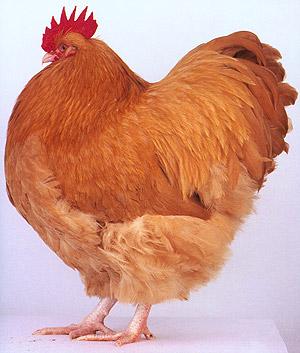

Buff Orpington Buff Forkington
Errata-In this tome, it is said Tom goes to Mr. D's home in Waterfield. The current tally of Damon's many moves stands at 12-Waterfield, 6-not recorded or confused, and 10-Waterford, for 25 volumes, to date. The numbers don't total, because two volumes have him residing in both places at the same time. Six others either do not specify a town name, or have multiple references that change.
Engineering and Science, Fact vs. Fantasy-
The Swift Hercules design-The monster loco Tom designs is indeed the "marvel of the age." It is (as usual) 50% faster, more powerful, bigger and heavier than the competition. (See below.) There are a few issues, however that the author missed. Hercules was described as having a leading 4 wheel truck (guide) and a 4 wheel trailer, with 12 drivers in between. This configuration could be called a 4-12-4. The numbers used describe the arrangement of the guiding (un-powered) and driving (powered) wheels. In reality, this 90 ft monster would have to be articulated in the center since a 90 ft long solid frame locomotive would need outrageous track radiuses to keep from jumping the rails in turns. That means the configuration would more properly be called a 4-6-0 0-6-4. The "oughts" in the center represent phantom wheel-sets that would exist if the two driving units were in separate structures (i.e. two small engines coupled together instead of one big standalone.) Another issue has to do with speed vs. power. To go fast, you gear a drive one way. To haul heavy loads, you gear a completely different way. Since shiftable drive transmissions for locos did not exist and you get either speed or power. Tom must have been using the Force to rocket this thing to 120 mph and haul a drag up the side of a mountain. One final issue, pumping DC electricity into long transmission lines creates fantastic energy waste and danger. To run at slow speed, you throw away most of the electrical energy as heat. Later trains all ran on AC current and used transformers plus rectifiers to convert what they used on-board. See also, The Real Hercules, below.
I can find no reference to Jandel Electric Locomotives in a Google search, except in regards to this story.
The Competition-Electric Locomotives:
From the early years of the 20th century Baldwin had a relationship with the Westinghouse Electric Company to build electric locomotives for American and foreign markets. The electric locomotive was increasingly popular and electrification was expensive, but for high traffic levels or mountainous terrain it could pay for itself. Baldwin built or subcontracted out the bodywork and running gear, and Westinghouse built the electrical gear.
Baldwin built the famed EP-1 (1906), EF-1 (1912) and EP-2 (1923) box cab electric locomotives for the New York, New Haven and Hartford Railroad. Baldwin also delivered the EP-3 box cab electric locomotives to the Milwaukee Road for use on their line between Harlowton, Montana and Avery, Idaho. (See RR Reality)
The following images and captions are from http://donsdepot.donrossgroup.net/dr546.htm
A Big Electric Train-The 1923 EP-2
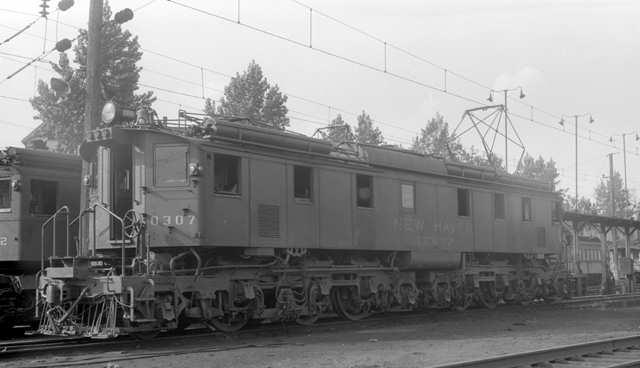
New York, New Haven & Hartford electric locomotive, engine number 0307.
{EP-2, built 1923 by Baldwin-Westinghouse, primarily used in passenger service with occasional use in freight service, retired in 1957}
Engine type BLW 1C1+1C1 From the Otto C. Perry Collection
Photographed: New Haven, Conn., August 18, 1937
Bigger Still-The 1919 Baldwin EP-3
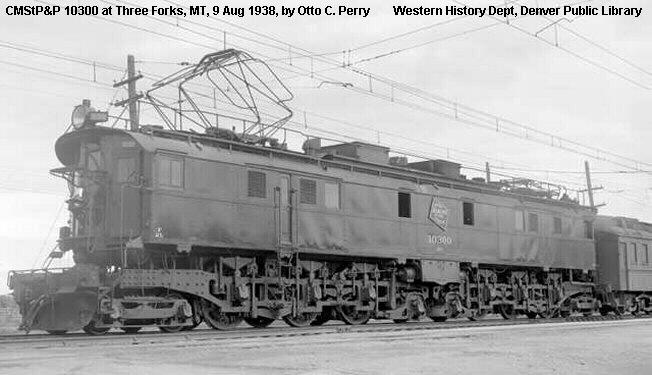
10301, Class EP-3, was built by Baldwin-Westinghouse in June 1919, #51844.
This looks to be representative of what Tom was trying to build.
FYI EP=Electric Passenger. EF=Electric Freight.
Really, Really Big-The 1916 Alco-GE EF-1
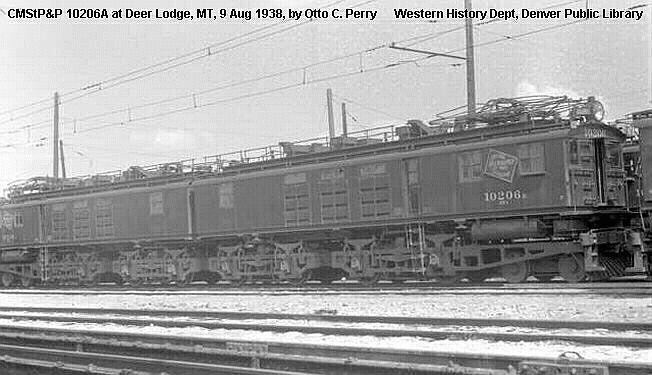
10208A, Class EF-1, was built in January 1916, by Alco and General Electric.
Note 4-8-0 0-8-4 Configuration. Four-up on Tom's 4-6-0 0-6-4.
This is representative of what Tom was trying to beat.
Things to come-The Real Hercules...The Baldwin GG-1
The following is from http://www.absoluteastronomy.com/encyclopedia
Baldwin built several electric locomotive types for the Pennsylvania Railroad as well including the P5A, R1 and the famed GG1. Baldwin built the first GG1 prototype electric locomotive for use on the Pennsylvania Railroad's electrified line that was completed in 1935 between New York and Washington, DC. A total of 139 units were constructed. They remained in service with the PRR's successors until the early 1980s. The GG1 became one of the most recognized and famous classes of locomotive worldwide.
Technical information: The
GG1s were large locomotives, 79ft 6in (24.2m) long and weighing 477,000 lb
(216,000 kg). The main body was a single unit formed as a bridge-truss framework
and clad in welded steel plate. The driving cabs were set up high about a third
of the way along the locomotive from each end for greater crew safety in an
accident. A narrower section of nose in front of the cab windows enabled view
forward, although the nose remained full height to carry the current-collection
pantographs. The bodywork as a whole was smoothly rounded.
This was mounted upon two great cast steel locomotive
frames linked by a hinge at the locomotive's middle which allowed side-to-side
movement. Six driving wheels (three axles) were
fitted towards the center of the locomotive on each truck (twelve in total) and
a four-wheeled, un-powered guiding truck was mounted toward each end. In the
(Click link for more info and facts about Whyte
notation) Whyte
notation for steam locomotives, each frame
comprised a 4-6-0 locomotive; in the
(Click link for more info and facts about PRR's
classification system) PRR's
classification system, 4-6-0s were class "G". The GG-1 consisted of two such
locomotive frames mounted back to back, so it was classified GG-4-6-0+0-6-4.
This arrangement is called 2-C+C-2 in (Click link for
more info and facts about AAR wheel arrangement) AAR
wheel arrangement notation.
Each driven axle was powered by two 385hp (288 kW)
GEA-627-A1 traction motors mounted above and to either side of the axle. Drive
was through a reduction gear and a quill
drive assembly.
The GG1 was designed to run on the standard Pennsylvania Railroad caternary
power of 11,000V AC, 25 Hz. This high voltage was stepped down by a large
transformer mounted in the center of the locomotive body for the traction
motors, cooling blowers and all other onboard equipment. The locomotive's power
was controlled via a tap-switching arrangement; the number of secondary windings
in use could be varied, thus adjusting the output voltage (and speed.)
The units were rated at 4,620 hp (385 per motor) continuous rating and a maximum
of 9,500 hp at 49 mph (intermittent duty). For
passenger service, the GG1 was geared to run at 100 mph maximum although it
achieved 110 mph in testing. For freight service, the locomotive was geared to
run at 90 mph maximum speed.

Baldwin GG-1 from http://www.northeast.railfan.net/electric5.html
These specs matched Tom's design criteria almost exactly, except for top speed and voltage type & supply. Reality, however, took another 13 years (1935) to catch up to the Our Hero's innovative thinking.

The Other Extreme-These locos are built to Z Scale. The image is full sized.
Driver wheels measure 0.25inch diameter. From the website of:
ANIMATO J-E Nystr–m, Ulvilantie 2 A 7, 00350 Helsinki, Finland
Geography- Swift Construction has continually grown, and is now surrounded by a high stockade fence that is topped with electrified barbed wire. This fenced-in property is sufficiently large that a 2-mile long circular railroad test track can fit inside it. There goes the neighborhood...
Koku now lives in an apartment over the Swifts' garage, and note is made that a special bed had to be constructed because of his large, but unspecified height and weight.
Rad is now living in a room or rooms near the attic in the Swift manse. Previously he had been housed in a space over his mule Boomerang's stable. Boomerang has passed on.
The Chicago, Milwaukee, and St. Paul RR. Could have been the model for the fictional H&PA RR. A major expansion of that railroad occurred in the 1900s. Between 1906 and 1909, new railroad lines were built from South Dakota to Puget Sound and the Seattle/Tacoma region of Washington. The railroad also pioneered long-distance electrification, completing over 400 miles of track, beginning in central Montana by 1916. In electrifying the track, company managers hoped the savings from using hydroelectric power would offset the cost of the electrification, and provide lower costs hauling trains over the 2.2% grades of the line. While the electrification was an engineering marvel of the day, in the end they did not contribute to the success of the company and are believed to have led to the company's bankruptcy in 1925.
JP Karenko 9/13/05
![]()
Tom Swift Among the Fire Fighters | Tom Swift and his Flying Boat | Index